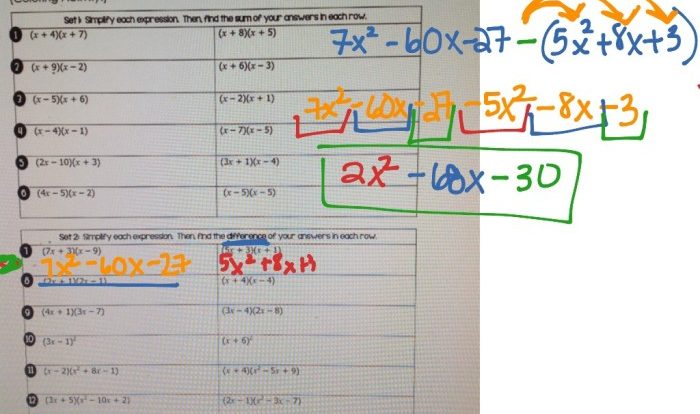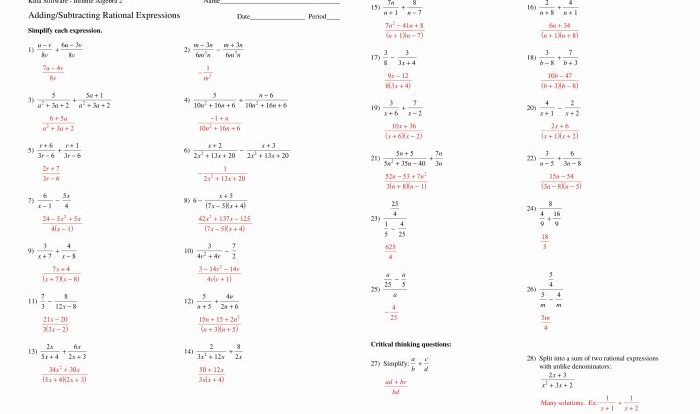Welcome to the realm of ‘Big Ideas Math Book Algebra 1,’ where mathematical concepts dance with clarity and real-world applications. This textbook is a symphony of knowledge, tailored to guide students through the intricacies of Algebra 1. Join us as we delve into its pages, exploring the fundamental ideas that shape our understanding of the world.
Big Ideas Math Book Algebra 1 empowers learners with a deep understanding of functions, equations, and polynomials. It employs an innovative approach that emphasizes problem-solving and real-world applications, making mathematics not just a subject but a tool for understanding the complexities of our surroundings.
Introduction to ‘Big Ideas Math Book Algebra 1’

Big Ideas Math Book Algebra 1 is a comprehensive textbook designed to provide a solid foundation in algebra for high school students. It aims to make algebra accessible and engaging for learners of all levels, fostering a deep understanding of algebraic concepts and their applications in real-world scenarios.
The book covers a wide range of topics, including:
- Variables and expressions
- Solving equations and inequalities
- Graphing linear and quadratic functions
- Polynomials and factoring
- Rational expressions and equations
- Radical expressions and equations
- Quadratic equations and functions
- Exponential and logarithmic functions
li>Systems of equations and inequalities
Mathematical Concepts
The core mathematical concepts in ‘Big Ideas Math Book Algebra 1’ encompass the fundamental building blocks of algebra, fostering a comprehensive understanding of the subject. These concepts are introduced gradually and developed throughout the book, providing a structured learning journey for students.
The book focuses on key concepts such as functions, equations, and polynomials, laying the foundation for further mathematical exploration. Functions are presented as relationships between variables, while equations represent mathematical statements that equate two expressions. Polynomials, as expressions involving variables and coefficients, are explored in-depth, emphasizing their properties and operations.
Functions
- Definition of a function as a relation between two sets, where each element of the first set (domain) corresponds to exactly one element of the second set (range).
- Exploration of different types of functions, including linear, quadratic, and exponential functions, through real-world examples and graphical representations.
- Analysis of function properties, such as domain, range, and continuity, to understand their behavior and characteristics.
Equations
- Introduction to equations as mathematical statements that equate two expressions, involving variables and constants.
- Solving linear and quadratic equations using various techniques, including factoring, completing the square, and using the quadratic formula.
- Understanding the concept of systems of equations and solving them using substitution, elimination, or graphing methods.
Polynomials
- Definition of a polynomial as an expression involving variables and coefficients, with non-negative integer exponents.
- Operations on polynomials, including addition, subtraction, multiplication, and division, with a focus on polynomial identities and factorization.
- Exploration of polynomial functions, their graphs, and their applications in real-world contexts.
al Approach
The al approach emphasizes problem-solving and real-world applications, equipping students with critical thinking and analytical skills essential for success in algebra and beyond.
The book employs a variety of visuals, examples, and exercises to enhance understanding and reinforce concepts. These include:
Visuals
- Charts and graphs help students visualize mathematical relationships and patterns.
- Diagrams and illustrations clarify complex concepts and make them more accessible.
Examples
- Worked-out examples demonstrate step-by-step solutions, providing a model for students to follow.
- Real-world examples connect mathematical concepts to everyday situations, making learning more relevant.
Exercises, Big ideas math book algebra 1
- Practice exercises provide opportunities for students to apply their understanding and develop their problem-solving abilities.
- Challenge exercises encourage students to extend their thinking and explore more advanced concepts.
Assessment and Practice
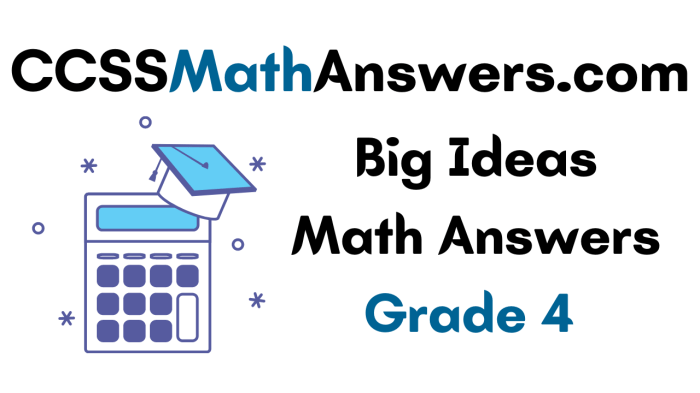
The ‘Big Ideas Math Book Algebra 1’ incorporates various assessments to aid students in tracking their understanding and solidifying their learning.
While “Big Ideas Math Book Algebra 1” delves into mathematical concepts, if you need a break from equations, take a detour to our WWE quiz and test your knowledge of wrestling legends. Afterward, return refreshed and ready to conquer those algebraic equations in “Big Ideas Math Book Algebra 1.”
Chapter reviews and practice exercises are key components of the assessment system within the book.
Chapter Reviews
Chapter reviews provide a comprehensive assessment of each chapter’s content. They include a range of questions, such as multiple-choice, short answer, and extended response, that test students’ understanding of the concepts covered in the chapter.
Practice Exercises
Practice exercises are designed to reinforce learning and provide students with ample opportunities to apply the concepts they have learned. These exercises vary in difficulty and include both basic and more challenging problems.
Supplementary Materials
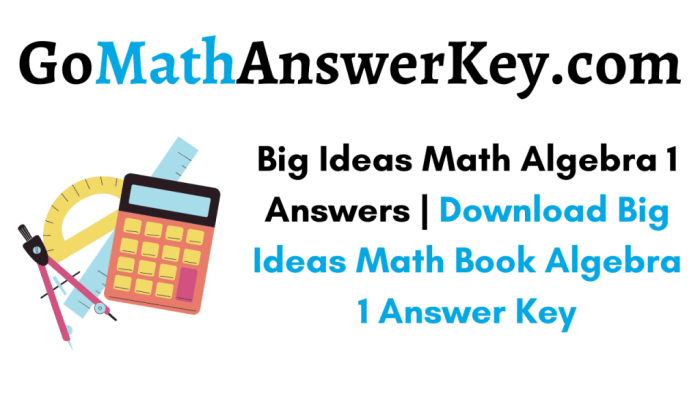
To enhance the learning experience, Big Ideas Math Book Algebra 1 offers a comprehensive suite of supplementary materials that cater to diverse learning styles and support effective teaching.
These materials include online resources, teacher guides, and additional practice exercises that complement the textbook and facilitate deeper understanding of mathematical concepts.
Online Resources
- Interactive Simulations and Animations:Engage students with dynamic simulations and animations that bring abstract concepts to life, fostering a deeper comprehension of mathematical principles.
- Online Quizzes and Games:Provide interactive assessments that allow students to practice their skills and receive immediate feedback, promoting self-paced learning and retention.
- Video Tutorials and Explanations:Offer clear and concise video demonstrations of mathematical concepts, providing an alternative learning medium that caters to visual learners.
Teacher Guides
- Lesson Plans and Pacing Guides:Assist teachers in planning and delivering effective lessons, providing detailed Artikels and pacing suggestions that ensure efficient coverage of the curriculum.
- Assessment Tools and Answer Keys:Equip teachers with a range of assessment options, including chapter tests, quizzes, and answer keys, facilitating accurate student evaluation and progress tracking.
- Professional Development Resources:Provide ongoing support for teachers, offering access to workshops, training materials, and online communities that promote professional growth and enhance teaching effectiveness.
Additional Practice Exercises
- Practice Worksheets and Homework Assignments:Supplement the textbook with additional practice exercises that reinforce concepts, develop problem-solving skills, and prepare students for assessments.
- Challenge Problems and Enrichment Activities:Extend the learning experience with challenging problems and enrichment activities that stimulate critical thinking, encourage exploration, and foster a love of mathematics.
- Differentiated Instruction Materials:Cater to diverse learning needs with differentiated instruction materials that provide targeted support and enrichment opportunities for students at various levels.
Comparison to Other Algebra 1 Textbooks
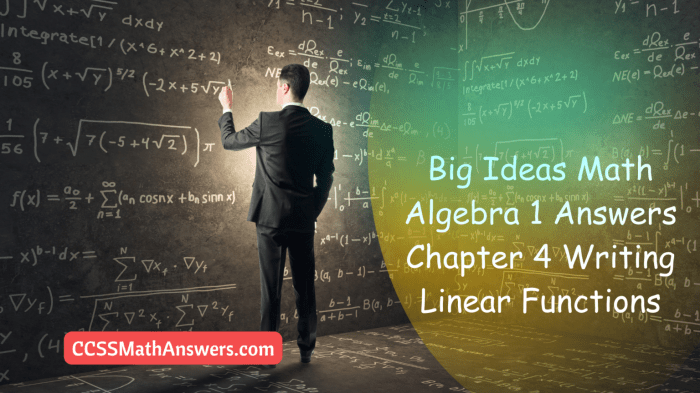
Big Ideas Math Book Algebra 1 stands out from other popular Algebra 1 textbooks with its emphasis on conceptual understanding, real-world applications, and a blended learning approach.
Compared to traditional textbooks that focus on memorization and rule-based problem-solving, Big Ideas Math takes a more engaging approach by presenting concepts in a way that makes them relatable and accessible to students.
Unique Strengths
- Concept-Based Approach:Big Ideas Math prioritizes building students’ conceptual understanding by connecting mathematical concepts to real-world scenarios and hands-on activities.
- Visual and Interactive Learning:The textbook incorporates numerous visual aids, such as diagrams, charts, and interactive simulations, to enhance understanding and engagement.
- Blended Learning Experience:Big Ideas Math seamlessly integrates online resources and digital tools, providing students with a personalized and flexible learning experience.
Potential Limitations
- May Require Additional Resources:While Big Ideas Math provides a solid foundation, it may require supplemental materials or teacher guidance for students who need more support.
- Pace and Depth:The textbook covers a comprehensive range of topics, but some concepts may be presented at a faster pace than in other textbooks, requiring students to keep up.
FAQ: Big Ideas Math Book Algebra 1
Is ‘Big Ideas Math Book Algebra 1’ suitable for self-study?
Yes, the book’s clear explanations and ample practice exercises make it an excellent resource for independent learners.
How does ‘Big Ideas Math Book Algebra 1’ compare to other Algebra 1 textbooks?
It stands out with its emphasis on problem-solving and real-world applications, making it more engaging and relevant for students.
Are there any online resources available to supplement ‘Big Ideas Math Book Algebra 1’?
Yes, the book comes with access to online resources such as videos, interactive exercises, and additional practice problems.
